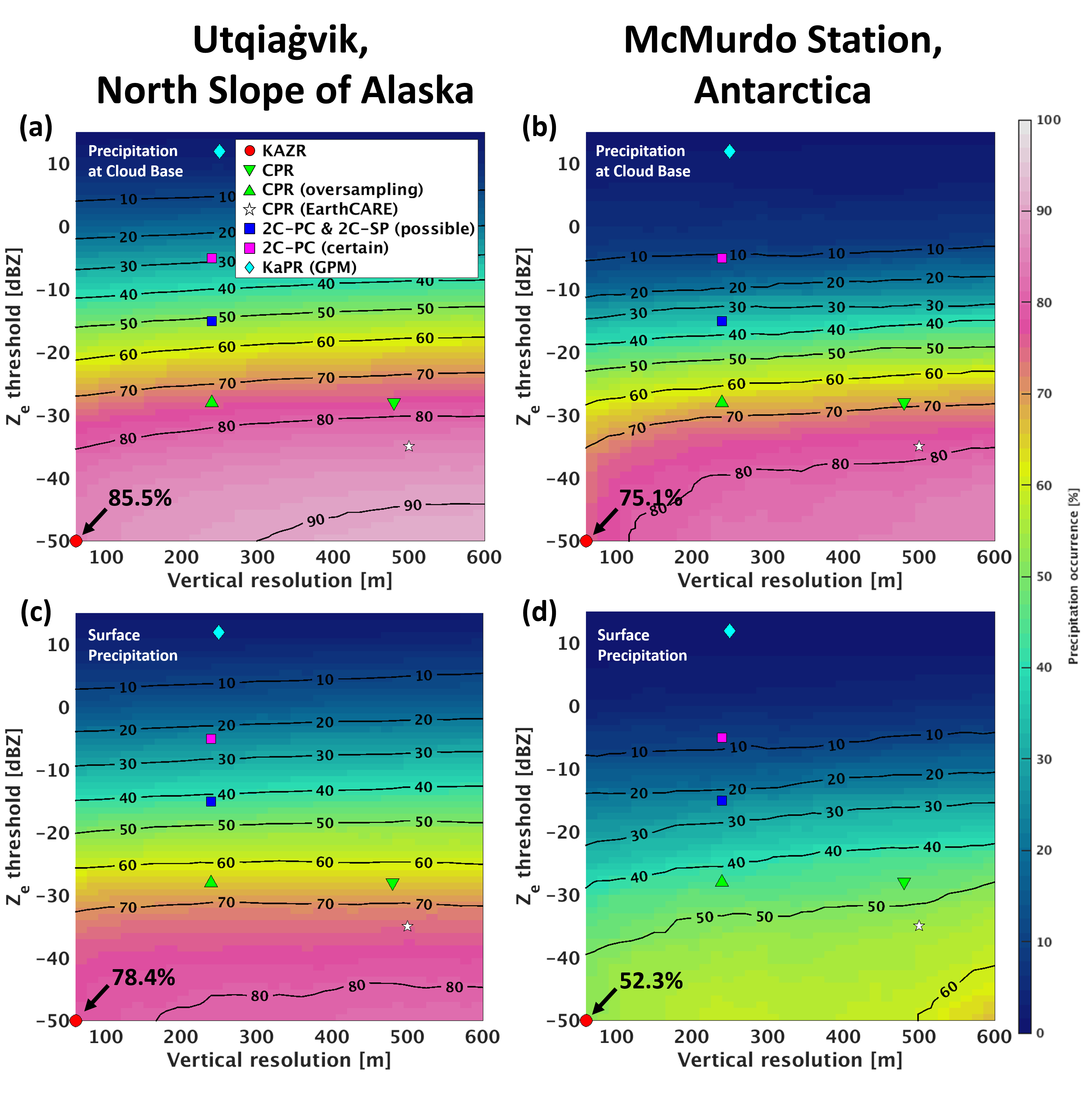A prevalence of precipitation from polar supercooled clouds
Submitter
Silber, Israel — Pacific Northwest National Laboratory
Fridlind, Ann M.
— Goddard Institute for Space Studies
Area of Research
Cloud Processes
Journal Reference
Silber I, A Fridlind, J Verlinde, A Ackerman, G Cesana, and D Knopf. 2021. "The prevalence of precipitation from polar supercooled clouds." Atmospheric Chemistry and Physics, 21(5), 10.5194/acp-21-3949-2021.
Science

Figure 1. Precipitation occurrence over the arctic site (left) and antarctic site (right) as a function of radar range resolution and equivalent radar reflectivity (Ze) threshold: (a,b) for all supercooled cloud layers at liquid cloud base, (c,d) for surface precipitation from all layer-containing columns. Symbols indicate the range resolutions and detectability thresholds for the KAZR (at ~1 km) and various spaceborne radars and precipitation detection algorithms. From journal.
Based on long-term measurements over Alaska and Antarctica, we find that a great majority of supercooled clouds are at least weakly precipitating at cloud base over a wide range of cloud top temperatures and that some precipitation reaches the surface in most instances. We demonstrate that such high frequencies of precipitation can be reconciled with substantially lesser spaceborne estimates by considering differences in radar sensitivity. While ice precipitation into supercooled clouds from aloft is common, we also find that a similarly great majority of supercooled cloud layers without ice falling into them are themselves continuously generating precipitation.
Impact
Supercooled clouds substantially impact polar surface energy budgets but large-scale models often underestimate their occurrence, which motivates accurately establishing metrics of fundamental processes to guide model development. Outstanding uncertainties in precipitation formation processes in supercooled clouds and their parameterization in models further motivate a focus on directly constraining precipitation rates using long-term measurements over polar regions. We argue that evaluating precipitation rate at cloud base improves the robustness of observational statistics and improves isolation of model precipitation process biases from those associated with the underlying atmospheric thermodynamic profile.
Summary
Using sounding and profiling radar measurements, we find that more than 85% (75%) of supercooled layers detected over an arctic (antarctic) site are precipitating at cloud base, with more than 75% (50%) precipitating continuously to the surface. For the unseeded supercooled clouds that are similarly usually precipitating, sustained primary ice formation is consistent with continuous activation of immersion-mode ice nucleating particles, suggesting that supercooled cloud formation is a principal gateway to ice formation at temperatures greater than ~–38 °C over polar regions. The prevalence of weak precipitation fluxes is also consistent with supercooled cloud longevity, and with well-observed and widely simulated case studies. However, based on liquid water path in single-layer clouds, we find that even weak precipitation fluxes may non-negligibly impact in-cloud moisture budgets owing to commonly low cloud water contents. Finally, since supercooled clouds that are precipitating ice are also mixed-phase clouds, our results demonstrate that the observed abundance of mixed-phase clouds can vary substantially with instrument sensitivity and methodology.
Keep up with the Atmospheric Observer
Updates on ARM news, events, and opportunities delivered to your inbox
ARM User Profile
ARM welcomes users from all institutions and nations. A free ARM user account is needed to access ARM data.


















